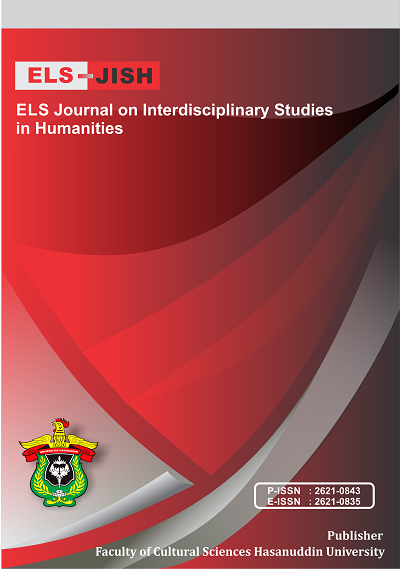Interpersonal Meaning in the Gettysburg Address (Systemic Functional Analysis)
DOI:
https://doi.org/10.34050/elsjish.v5i4.24847Keywords:
Interpersonal Meaning, Mood, Modality, Gettysburg AddressAbstract
This study aims to uncover the types of mood and modality used in the Gettysburg Address and how Abraham Lincoln uses them to give dedication and emphasize the struggle to achieve union and equality. This study employed descriptive qualitative research design in analyzing the data. the data were collected from the text of the Gettysburg Address. After the data were collected, they were categorized into their proper interpersonal meaning elements classification. Then, the writer determined whether the data are in declarative mood, imperative mood, or interrogative mood, and revealed the type, orientation, and value of the modalities. Finally, the writer explained the mood and modality used by the speaker to give dedication and emphasize the struggle to achieve union and equality. The result shows that declarative mood occurs the most compared to the imperative mood. By using declarative mood, the speaker explains that they are struggling to win the war, they are going to give dedication for the fallen soldiers, and they are continuing their unfinished work to achieve union and equality. Meanwhile, the speaker uses imperative mood to command the listener that they must dedicate a portion of the aftermath field for their fallen soldiers who struggled to achieve union and equality. In using modality, the speaker positions their messages in the degree of Probability, Obligation, Inclination, and usuality. Most of them are in a high value and the rest are in median and low value.
References
Bachriani, B., Yassi, A. H., & Rahman, F. (2018). A Comparative Study of Euphemism in English and Buginese: Pragmatic Stylistics Contexts. ELS Journal on Interdisciplinary Studies in Humanities, 1(4), 429-440.
Butt, D., Fahey, R., Feez, S., Spinks, S., & Yallop, C. (2003). Using Functional Grammar: An Explorer's Guide (2nd ed.). Sydney: Macquarie University.
Eggins, S. (2005). An Introduction to Systemic Functional Linguistics (2nd ed.). London: Continuum.
Gerot, L., & Wignell, P. (1994). Making Sense of Functional Grammar. New South Wales: Antipodean Educational Enterprise.
Halliday, M., & Webster, J. J. (2009). Continuum Companion to Systemic Functional Linguistics. New York: Continuum International Publishing Group.
Halliday, M., & Hasan, R. (1989). Language, Context, and Text: Aspects of Language in a Social-Semiotic Perspective. (F. Christie, Ed.) Oxford: Oxford University Press.
Halliday, M., & Matthiessen, C. M. (2014). Introduction to Functional Grammar (4th ed.). Oxon: Routledge.
Huabin, W. (2018, April 1). Interpersonal Meaning of Code-switching: An Analysis of Three TV Series. Australian Journal of Applied Linguistics, 1(1), 3-19.
İlhan, E. G., & Erbaş, A. K. (2016, January 27). Discourse Analysis of Interpersonal Meaning to Understand the Discrepancy between Teacher Knowing and Practice. Eurasia Journal of Mathematics, Science & Technology Education, 12(8), 2237-2251.
Koutchadé, I. S. (2016, September). The Grammar of Interpersonal Meaning in Wole Soyinka’s A Play of Giants. Mediterranean Journal of Social Sciences, 7(5), 299-309.
Lock, G. (1995). Functional English Grammar: An Introduction for Second Language Teachers. Cambridge: Cambridge University Press.
Martin, J. (1992). English Text: System and structure. Amsterdam: John Benjamins Publishing Company.
McNamara, R. (2018, August 31). Abraham Lincoln and the Gettysburg Address. Retrieved june 1, 2019, from ThoughtCo: https://www.thoughtco.com/abraham-lincoln-and-the-gettysburg-address-1773573
McPherson, J. (n.d.). A Brief Overview of the American Civil War. Retrieved May 16, 2019, from American Battlefield Trust: https://www.battlefields.org/learn/articles/brief-overview-american-civil-war
Ping, K., & Lingling, L. (2017). Application of Interpersonal Meaning in Hillary’s and Trump’s Election Speeches. Advances in Language and Literary Studies , 8(6), 28-36.
Rahman, F., & Weda, S. (2019). Linguistic Deviation and The Rhetoric Figures in Shakespeare’s Selected Plays. XLinguage European Scientific Language Journal, 12(1), 37-52.
Simon-Vandenbergen, A.-M., Taverniers, M., & Ravelli, L. J. (2003). Grammatical Metaphor: Views from Systemic Functional Linguistics. Amsterdam: John Benjamins.
Syamsurrijal, B. A., Makka, M., & Rahman, F. (2019). Indirect Meaning of Tembang Dangdang Gule Saking Sunan Bonang in Sasak Wedding Ceremony. International Journal of Science and Research (IJSR), 8(10), 954-959.
Transcript of Cornell University’s Copy. (2018). Retrieved November 20, 2018, from Cornell University: http://rmc.library.cornell.edu/gettysburg/good_cause/transcript.htm
Downloads
Published
Issue
Section
License
Copyright (c) 2022 Andi Risang Qinthar Latunra

This work is licensed under a Creative Commons Attribution-NonCommercial-ShareAlike 4.0 International License.






